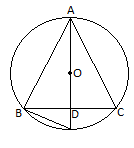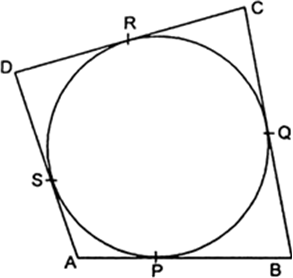Ask questions which are clear, concise and easy to understand.
Ask QuestionPosted by Vinay Waldia Waldia 5 years, 3 months ago
- 1 answers
Posted by Sachin Chaudhary 5 years, 3 months ago
- 2 answers
Posted by Deepak Mishra 5 years, 3 months ago
- 1 answers
Yogita Ingle 5 years, 3 months ago
Let us assume that √5 is a rational number.
Sp it t can be expressed in the form p/q where p,q are co-prime integers and q≠0
⇒√5=p/q
On squaring both the sides we get,
⇒5=p²/q²
⇒5q²=p² —————–(i)
p²/5= q²
So 5 divides p
p is a multiple of 5
⇒p=5m
⇒p²=25m² ————-(ii)
From equations (i) and (ii), we get,
5q²=25m²
⇒q²=5m²
⇒q² is a multiple of 5
⇒q is a multiple of 5
Hence, p,q have a common factor 5. This contradicts our assumption that they are co-primes. Therefore, p/q is not a rational number
√5 is an irrational number
Posted by Pruthvi Tandel 5 years, 3 months ago
- 2 answers
Posted by Aditya Alok 5 years, 3 months ago
- 0 answers
Posted by Samarth Tembhurnikar 5 years, 3 months ago
- 1 answers
Aditya Alok 5 years, 3 months ago
Posted by Sneha Patil 5 years, 3 months ago
- 2 answers
Yogita Ingle 5 years, 3 months ago
The first 3-digit number which is divisible by 7 is 105
The last 3-digit number which is divisible by 7 is 994
The list of 3-digit numbers divisible by 7 are
105, 112, 119,…..994 which forms an A.P
Consider a formula
T(n) = a + (n – 1)d
Where
a = 105
d = 7
T(n) = 994
994 = 105 + (n – 1)7
889 = 7n – 7
7n = 896
n = 128
∴ There are 128 3-digits number which are divisible by 7.
Samarth Tembhurnikar 5 years, 3 months ago
Posted by Sneha Patil 5 years, 3 months ago
- 1 answers
Yogita Ingle 5 years, 3 months ago
let the required term be nth term
54th term = a +(n-1)d
= 3 + 53x12 = 3 + 636 = 639
therefore 132 + 639 = 771 will be the nth term.
771 = 3 + (n-1)12
768/12 +1 = n
therefore n = 64 +1 = 65
therefore the 65th term will be 132 more than the 54th term
Posted by Sneha Patil 5 years, 3 months ago
- 3 answers
Khush Kaur 5 years, 3 months ago
Aryan Gautam 5 years, 3 months ago
Posted by Srusti Samikshya 5 years, 3 months ago
- 1 answers
Gaurav Seth 5 years, 3 months ago
Here given triangle ABC must be an equilateral triangle and we have to prove AD2 = 3DC2
Solution:
Given: ∆ABC is an equilateral, AD ⊥ BC.

In right ∆ABD,
AB2 = BD2 + AD2
⇒ BC2 = BD2 + AD2 (AB = BC)
⇒ (2BD)2 = BD2 + AD2 [From (1)]
⇒ 4BD2 = BD2 + AD2
⇒ AD2 = 3BD2 = 3DC2 [As BD = DC]
Hence proved
Posted by Manya Jayakumar 5 years, 3 months ago
- 0 answers
Posted by Nakshatra Singh Rajawat 5 years, 3 months ago
- 4 answers
Dhara Ramesh 5 years, 3 months ago
Posted by Julia Biji John 5 years, 3 months ago
- 2 answers
Posted by Suraj Kumar 5 years, 3 months ago
- 0 answers
Posted by Kashish Dua 5 years, 3 months ago
- 1 answers
Posted by Khushi Gangwani 5 years, 3 months ago
- 2 answers
Posted by Ayush Kumar Das 5 years, 3 months ago
- 1 answers
Posted by Akash Bajantri 5 years, 3 months ago
- 0 answers
Posted by K. Asritha 5 years, 3 months ago
- 3 answers
Aastha Porwal 5 years, 3 months ago
Posted by Kritarth Bardia 4 years, 6 months ago
- 1 answers
Sia ? 4 years, 6 months ago
Both the current ratio, also known as the working capital ratio, and acid-test ratio measure a company's short-term ability to generate enough cash to pay off all debts should they become due at once.
Posted by K. Asritha 5 years, 3 months ago
- 2 answers
Meenal Khandelwal 5 years, 3 months ago
Posted by Chethan Kadavath 5 years, 3 months ago
- 5 answers
Posted by Vinayak More 5 years, 3 months ago
- 5 answers
Meenal Khandelwal 5 years, 3 months ago
Posted by Atul Kumar 5 years, 3 months ago
- 5 answers
Posted by Vicky Kumar 5 years, 3 months ago
- 1 answers
Gaurav Seth 5 years, 3 months ago
Radius of the circle = 32 cm
Draw a median AD of the triangle passing through the centre of the circle.
⇒ BD = AB/2
Since, AD is the median of the triangle
∴ AO = Radius of the circle = 2/3 AD
⇒ 2/3 AD = 32 cm
⇒ AD = 48 cm
In ΔADB,
<a href="https://3.bp.blogspot.com/-gsz4sf7No4w/VYwFPSkyvbI/AAAAAAAABA4/6QBibJ98sAw/s1600/ch12-class10-maths-area-related-to-circles-6.png" rel="nofollow" target="_blank"> </a>
</a>
By Pythagoras theorem,
AB2 = AD2 + BD2
⇒ AB2 = 482 + (AB/2)2
⇒ AB2 = 2304 + AB2/4
⇒ 3/4 (AB2) = 2304
⇒ AB2 = 3072
⇒ AB = 32√3 cm
Area of ΔADB = √3/4 × (32√3)2 cm2 = 768√3 cm2
Area of circle = π R2 = 22/7 × 32 × 32 = 22528/7 cm2
Area of the design = Area of circle - Area of ΔADB
= (22528/7 - 768√3) cm2
Posted by V Pawar 5 years, 3 months ago
- 2 answers
Posted by Saksham Rathore 5 years, 3 months ago
- 1 answers
Gaurav Seth 5 years, 3 months ago
A.P : 121, 117, 113...
a = 121
d = 117- 121= -4
Let an= 0
an = a + (n-1)d
⇒ 0 = 121 + (n-1)(-4)
⇒ 0 = 121 - 4n + 4
⇒4n = 125
⇒ n = 125/4
⇒ n = 31.25
n must be natural number therefore n= 32
Hence, 32nd term is first negative number.
Posted by Raksha Raksha 5 years, 3 months ago
- 2 answers
Posted by Aditya Raj 5 years, 3 months ago
- 2 answers

myCBSEguide
Trusted by 1 Crore+ Students

Test Generator
Create papers online. It's FREE.

CUET Mock Tests
75,000+ questions to practice only on myCBSEguide app
 myCBSEguide
myCBSEguide
Gaurav Seth 5 years, 3 months ago
Since, tangents drawn from an exterior point to a circle are equal in length.

∴ AP = AS ...(i)
BP = BQ ...(ii)
CR = CQ ...(iii)
and DR = DS ...(iv)
Adding (i), (ii), (iii) and (iv), we get
AP + BP + CR + DR = AS + BQ + CQ + DS
⇒ (AP + BP) + (CR + DR)
= (AS + DS) + (BQ + CQ)
⇒ AB + CD = AD + BC
Hence, AB + CD = BC + DA.
1Thank You